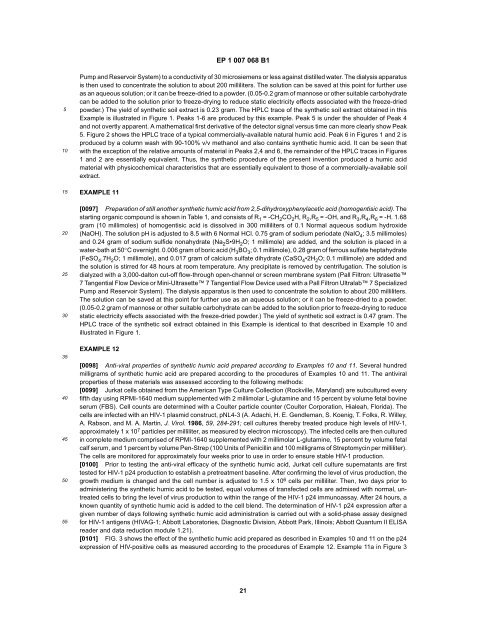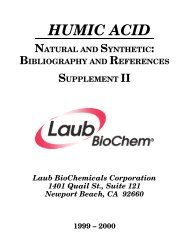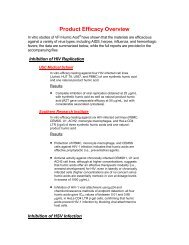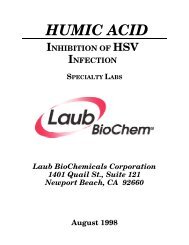HUMIC ACID - Laub BioChem
HUMIC ACID - Laub BioChem
HUMIC ACID - Laub BioChem
- No tags were found...
Create successful ePaper yourself
Turn your PDF publications into a flip-book with our unique Google optimized e-Paper software.
EP 1 007 068 B151015202530Pump and Reservoir System) to a conductivity of 30 microsiemens or less against distilled water. The dialysis apparatusis then used to concentrate the solution to about 200 milliliters. The solution can be saved at this point for further useas an aqueous solution; or it can be freeze-dried to a powder. (0.05-0.2 gram of mannose or other suitable carbohydratecan be added to the solution prior to freeze-drying to reduce static electricity effects associated with the freeze-driedpowder.) The yield of synthetic soil extract is 0.23 gram. The HPLC trace of the synthetic soil extract obtained in thisExample is illustrated in Figure 1. Peaks 1-6 are produced by this example. Peak 5 is under the shoulder of Peak 4and not overtly apparent. A mathematical first derivative of the detector signal versus time can more clearly show Peak5. Figure 2 shows the HPLC trace of a typical commercially-available natural humic acid. Peak 6 in Figures 1 and 2 isproduced by a column wash with 90-100% v/v methanol and also contains synthetic humic acid. It can be seen thatwith the exception of the relative amounts of material in Peaks 2,4 and 6, the remainder of the HPLC traces in Figures1 and 2 are essentially equivalent. Thus, the synthetic procedure of the present invention produced a humic acidmaterial with physicochemical characteristics that are essentially equivalent to those of a commercially-available soilextract.EXAMPLE 11[0097] Preparation of still another synthetic humic acid from 2,5-dihydroxyphenylacetic acid (homogentisic acid). Thestarting organic compound is shown in Table 1, and consists of R 1 =-CH 2 CO 2 H, R 2 ,R 5 =-OH,and R 3 ,R 4 ,R 6 =-H.1.68gram (10 millimoles) of homogentisic acid is dissolved in 300 milliliters of 0.1 Normal aqueous sodium hydroxide(NaOH). The solution pH is adjusted to 8.5 with 6 Normal HCl. 0.75 gram of sodium periodate (NaIO 4 ;3.5 millimoles)and 0.24 gram of sodium sulfide nonahydrate (Na 2 S•9H 2 O; 1 millimole) are added, and the solution is placed in awater-bath at 50°Covernight. 0.006 gram of boric acid (H 3 BO 3 ;0.1 millimole), 0.28 gram of ferrous sulfate heptahydrate(FeSO 4 .7H 2 O; 1 millimole), and 0.017 gram of calcium sulfate dihydrate (CaSO 4 •2H 2 O; 0.1 millimole) are added andthe solution is stirred for 48 hours at room temperature. Any precipitate is removed by centrifugation. The solution isdialyzed with a 3,000-dalton cut-off flow-through open-channel or screen membrane system (Pall Filtron: Ultrasette7Tangential Flow Device or Mini-Ultrasette 7 Tangential Flow Device used with a Pall Filtron Ultralab 7 SpecializedPump and Reservoir System). The dialysis apparatus is then used to concentrate the solution to about 200 milliliters.The solution can be saved at this point for further use as an aqueous solution; or it can be freeze-dried to a powder.(0.05-0.2 gram of mannose or other suitable carbohydrate can be added to the solution prior to freeze-drying to reducestatic electricity effects associated with the freeze-dried powder.) The yield of synthetic soil extract is 0.47 gram. TheHPLC trace of the synthetic soil extract obtained in this Example is identical to that described in Example 10 andillustrated in Figure 1.3540455055EXAMPLE 12[0098] Anti-viral properties of synthetic humic acid prepared according to Examples 10 and 11. Several hundredmilligrams of synthetic humic acid are prepared according to the procedures of Examples 10 and 11. The antiviralproperties of these materials was assessed according to the following methods:[0099] Jurkat cells obtained from the American Type Culture Collection (Rockville, Maryland) are subcultured everyfifth day using RPMI-1640 medium supplemented with 2 millimolar L-glutamine and 15 percent by volume fetal bovineserum (FBS). Cell counts are determined with a Coulter particle counter (Coulter Corporation, Hialeah, Florida). Thecells are infected with an HIV-1 plasmid construct, pNL4-3 (A. Adachi, H. E. Gendleman, S. Koenig, T. Folks, R. Willey,A. Rabson, and M. A. Martin, J. Virol. 1986, 59, 284-291; cell cultures thereby treated produce high levels of HIV-1,approximately 1 x 10 7 particles per milliliter, as measured by electron microscopy). The infected cells are then culturedin complete medium comprised of RPMI-1640 supplemented with 2 millimolar L-glutamine, 15 percent by volume fetalcalf serum, and 1 percent by volume Pen-Strep (100 Units of Penicillin and 100 milligrams of Streptomycin per milliliter).The cells are monitored for approximately four weeks prior to use in order to ensure stable HIV-1 production.[0100] Prior to testing the anti-viral efficacy of the synthetic humic acid, Jurkat cell culture supernatants are firsttested for HIV-1 p24 production to establish a pretreatment baseline. After confirming the level of virus production, thegrowth medium is changed and the cell number is adjusted to 1.5 x 10 6 cells per milliliter. Then, two days prior toadministering the synthetic humic acid to be tested, equal volumes of transfected cells are admixed with normal, untreatedcells to bring the level of virus production to within the range of the HIV-1 p24 immunoassay. After 24 hours, aknown quantity of synthetic humic acid is added to the cell blend. The determination of HIV-1 p24 expression after agiven number of days following synthetic humic acid administration is carried out with a solid-phase assay designedfor HIV-1 antigens (HIVAG-1; Abbott Laboratories, Diagnostic Division, Abbott Park, Illinois; Abbott Quantum II ELISAreader and data reduction module 1.21).[0101] FIG. 3 shows the effect of the synthetic humic acid prepared as described in Examples 10 and 11 on the p24expression of HIV-positive cells as measured according to the procedures of Example 12. Example 11a in Figure 321










